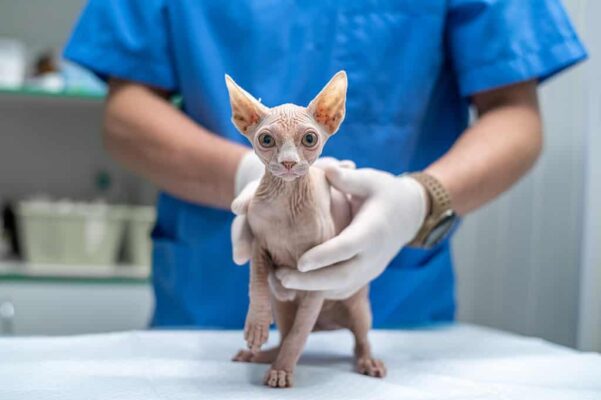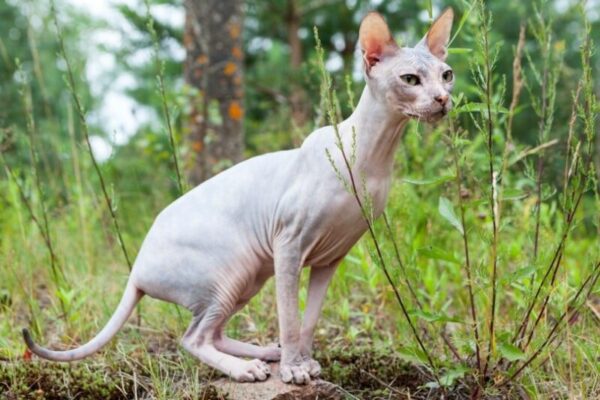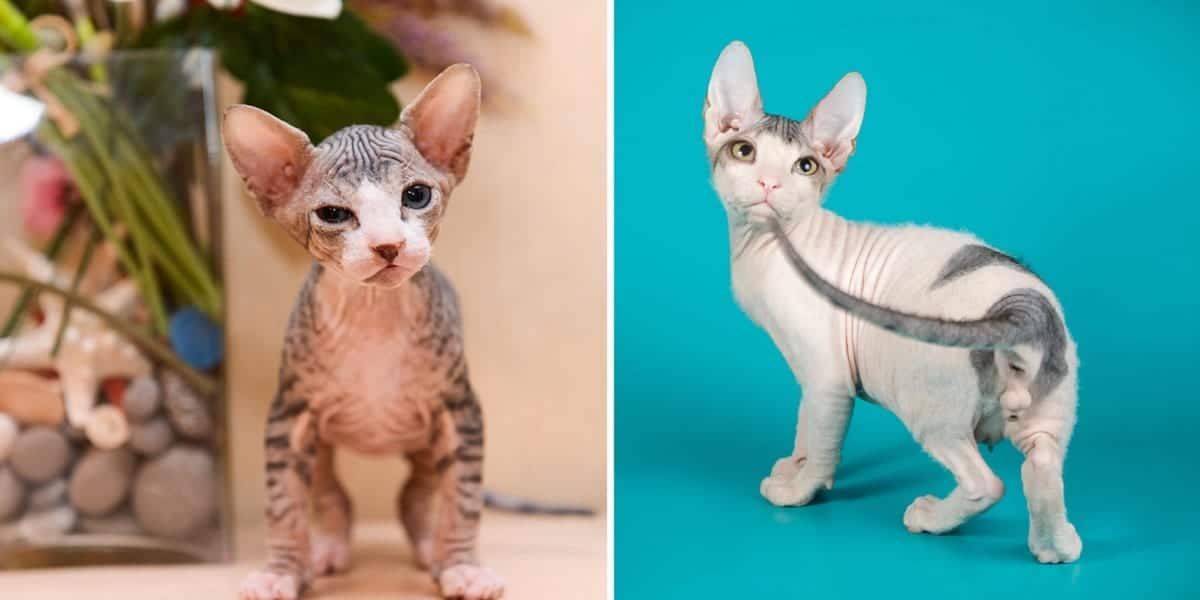As a cat lover, I’ve often heard people wonder if male or female Sphynx cats are better pets. I aim to help you choose the right one by sharing what I’ve learned from breeders, vets, and cat experts. They’ve given me insights into the unique traits of these hairless cats.
The Sphynx breed is known for its lack of fur and big eyes. These traits vary by gender, affecting their behavior and looks. I’ll explore these differences to help you pick a Sphynx cat that fits your home.
Key Takeaways
- Insightful comparison between male and female Sphynx cats for potential owners.
- Expert opinions from breeders and vets highlight the distinct traits of each gender.
- Physical and behavioral aspects of Sphynx cats will be examined to inform your choice.
- Critical factors to consider include lifestyle compatibility and personal preferences.
- Understanding the nuances of Sphynx cat care is essential for a harmonious relationship.
Introduction to Sphynx Cats
Welcome to the world of the Sphynx cat breed. These cats are known for their hairless look and cute wrinkles. Their skin feels like a peach and they love to be hugged and cuddled.
The Sphynx cat personality is unique. They act like a mix of a dog, a child, and a cat. These hairless cats are very social, energetic, and loyal to their owners. They love being around people and will often greet them at the door.
Even without fur, Sphynx cats need special care. They produce oil that would be absorbed by fur in other cats. So, they need regular baths to keep their skin healthy.
| Feature | Description |
|---|---|
| Appearance | Hairless, with wrinkled skin and large ears. |
| Personality | Affectionate, energetic, and attention-seeking. |
| Care Needs | Regular bathing, cleaning of ears and careful diet management to avoid obesity. |
The Sphynx cat breed is special in many ways. They are known for their deep understanding and empathy of their owners. Bringing a Sphynx into your home means adding a loving and lively member to your family.
Physical Differences Between Male and Female Sphynx Cats
Looking into the gender differences of Sphynx cats shows how size and weight affect pet choices. Male Sphynx cats are usually bigger than females. This can affect an owner’s choice based on space and personal taste.
Male Sphynx cats tend to be heavier. This weight difference impacts their diet, health, and activity levels. Females, on the other hand, have a smaller size. This means males look more robust, with a unique appearance.
Knowing these traits is key for future owners, breeders, and vets. They need to consider these differences when planning care or breeding. Here’s a closer look at the average sizes:
| Gender | Average Weight | Average Body Length |
|---|---|---|
| Male | 8-12 lbs | 13-15 inches |
| Female | 6-10 lbs | 11-13 inches |
Gender differences in size and weight are important for understanding how each cat fits into different homes. They help in setting up a comfortable living space or planning exercise routines. This way, owners can create a home that meets each Sphynx cat’s needs.
Behavioral Traits of Sphynx Cats
Sphynx cats show unique traits in both looks and behavior. This section explores the male Sphynx cat personality and female Sphynx cat personality. It highlights the behaviors that make these cats interesting.
Understanding Male Sphynx Cat Behavior
Male Sphynx cats are known for their confidence and curiosity. They love to explore and seek out people and things. They can be more territorial, which is important to know if you have other pets.
They also show a strong desire to be the center of attention. This can be fun but also a bit challenging for owners.
Understanding Female Sphynx Cat Behavior
Female Sphynx cats are often calmer and composed. They form strong bonds with their owners. They are less territorial than males but still like to get attention.
They use their eyes and meows to tell their owners what they need. This makes them very expressive.
Watching how these traits develop over time is fascinating. It shows how adaptable and emotionally smart Sphynx cats are. Despite not having fur, both males and females have warm personalities. This makes them beloved by their families.
Are Male or Female Sphynx Cats Better Companions?
Many people wonder if a male or female Sphynx cat makes a better pet. These hairless cats are very affectionate, making them great pets for many. The answer depends on your lifestyle and what you want in a pet. I’ll talk about how adaptable they are, how they get along with other pets, and their companionship qualities.

Adaptability to Households: Both male and female Sphynx cats adapt well to new homes. But, their personalities can affect how they fit in. Males are usually more laid-back and adjust quickly in busy homes. Females might take a bit longer but are just as loving once they feel at home.
- Interaction with Other Pets: Sphynx cats, no matter the gender, get along well with other pets. But, males might show more dominance. This is something to think about if you already have a dominant pet.
- Compatibility with Different Types of Owners: Females bond deeply with one person and are great for singles or those wanting a close bond. Males are more social and bond with all family members. They’re perfect for families.
From what Sphynx cat owners say, males are often seen as more easygoing. Females are sometimes chosen for their loyalty to one person. Yet, both genders bring a lot of joy and companionship to their owners.
Choosing between a male and female Sphynx cat is about what you prefer and your lifestyle. Both genders can greatly enrich your life with their affection and unique personalities. Think about how their traits fit with your home and how you interact with pets when making your decision.
Health and Longevity in Sphynx Cats
Looking into Sphynx cat health means understanding their special health challenges. These cats are loved for their unique look and loving nature. But, they face health issues that can affect their life expectancy and happiness. We’ll look at the genetic disorders Sphynx cats often get, focusing on the differences between males and females.
Common Health Issues in Male Sphynx Cats
Male Sphynx cats often face heart problems, especially hypertrophic cardiomyopathy (HCM). HCM is a common heart disease in cats, but it’s more common in male Sphynx cats. Owners need to watch closely and take steps to keep them healthy. These cats might also have skin issues because they don’t have fur, which can lead to infections or irritation. Keeping their skin clean and well-maintained is key.
Common Health Issues in Female Sphynx Cats
Female Sphynx cats also have their health challenges. They can get the same heart problems as males, like HCM. They might also face reproductive issues, such as polycystic ovary syndrome (PCOS), if breeding isn’t managed well or if they’re spayed too late. Regular vet visits are crucial to help manage these health issues and ensure they live a long life.
The life expectancy of a Sphynx cat, between 8 to 14 years, can be longer with good care. This means regular health checks for genetic disorders, proper skin care, and a balanced diet. These steps help them handle their fast metabolism and keep their body temperature stable.
| Condition | Impact Level | Common in Males | Common in Females |
|---|---|---|---|
| Hypertrophic Cardiomyopathy | High | Yes | Yes |
| Polycystic Ovary Syndrome | Medium | No | Yes |
| Skin Conditions | Variable | Yes | Yes |
The Effect of Spaying or Neutering on Sphynx Cats
Exploring the effects of spaying and neutering on Sphynx cats shows their benefits for pet population control and Sphynx cat health. These surgeries offer health and behavioral advantages that last a cat’s life.
Spaying or neutering stops unwanted litter, which is key to being a responsible pet owner and controlling the pet population. It also prevents health problems linked to their reproductive organs. For male Sphynx cats, neutering cuts down on marking territory and roaming, which can lead to accidents or fights.
- Reduces Risk of Certain Cancers: Spaying stops ovarian and uterine cancers in females, and neutering lowers testicular cancer risk in males.
- Longer Lifespan: Neutered or spayed cats often live longer, healthier lives. They’re less likely to roam and face dangers like traffic or aggressive animals.
- Behavioral Improvements: Neutered males are calmer and more predictable. Spayed females don’t exhibit heat-related behaviors like yowling or frequent urination.
Vets suggest spaying or neutering Sphynx cats between four to nine months old. This age is best for health benefits and avoiding early risks. Talking to a trusted vet can give you advice suited to your pet’s health and situation.
Deciding to spay or neuter your Sphynx cat should be based on its health and well-being now and in the future. Talking with a vet helps you make a choice that’s good for your pet and helps control the pet population.
Cost of Owning a Sphynx Cat
Thinking about getting a Sphynx cat? It’s key to know the initial cost and the ongoing expenses. These cats need special care and regular health checks. So, planning your budget is important.
The price of a Sphynx cat can change a lot. It depends on things like its history, age, and the breeder. But the cost doesn’t end with buying the cat. The Sphynx’s unique needs, like skin care and special food, also affect the budget.
Budgeting for pets, especially Sphynxes, means knowing about one-time and ongoing costs. Here’s a simple guide to help you plan your budget:
| Expense Category | Initial Cost | Ongoing Annual Costs |
|---|---|---|
| Acquisition | $1,500 – $3,000 | N/A |
| Grooming Supplies | $50 – $100 | $200 – $300 |
| Food | $80 – $150 | $600 – $1,200 |
| Veterinary Care (Routine) | $100 – $200 | $400 – $800 |
| Emergencies/Health Issues | N/A | $200 – $2,000 |
| Accessories and Bedding | $100 – $200 | $50 – $150 |
| Environmental Maintenance | $50 – $100 | $100 – $300 |
The costs of owning a Sphynx cat add up over time. So, it’s vital to budget well. If you’re thinking of getting one, make sure you can afford the care they need. This way, you can give your new pet a happy and healthy life.
The Pros and Cons of Male Sphynx Cats
Choosing a pet, especially a unique breed like the Sphynx, means looking at the good and bad sides of each gender. Male Sphynx cats have their own set of pros and cons. These factors can greatly affect your decision.
The Advantages of Owning a Male Sphynx
Male Sphynx cats are known for being friendly and loving attention. They are playful and outgoing, making them great companions. They also get along well with other pets and kids if introduced and socialized correctly.
- Stronger bond with family members
- Playful and energetic, providing entertainment and companionship
- Possessive nature which can be charming
The Disadvantages of Owning a Male Sphynx
While they have many good qualities, male Sphynx cats also come with challenges. One issue is territorial spraying, which can be fixed with early neutering. They are also more likely to get heart diseases like hypertrophic cardiomyopathy. Regular vet visits are a must.
- May require more frequent health monitoring
- Potential for dominant behaviors if not properly trained
- Sensitivity to cold due to lack of fur, requiring special care

When deciding to get a male Sphynx cat, weigh the pros and cons carefully. Think about how they fit into your lifestyle and what you expect from a pet. This careful thought will help you choose the right pet for you.
The Pros and Cons of Female Sphynx Cats
When choosing a pet cat, it’s key to look at the good and bad of each breed and gender. Female Sphynx cats stand out with their unique look and friendly nature. They bring many benefits and face special challenges.
Benefits of Female Sphynx Cats include being very loving, making them great friends in any home. They are less likely to be territorial than males, which means they get along better with other pets. Many owners say these cats are very caring and can feel their owner’s feelings, making the bond stronger.
But, the challenges of female Sphynx cats are important to know. They need a lot of care, especially for their health. They can have health problems that get worse if they’re not spayed due to hormonal changes during their heat cycle.
“The key to a thriving relationship with a female Sphynx cat is understanding and managing their unique needs.” – An experienced Sphynx cat breeder
- Social Needs: Female Sphynx cats love being around people. They can get sad if left alone for too long.
- Grooming Requirements: Even without fur, they need regular baths and skin care to avoid skin problems.
- Veterinary Checks: Seeing the vet often is important to keep an eye on health issues like heart and dental problems.
| Aspect | Advantage | Challenge |
|---|---|---|
| Temperament | Empathetic and sociable | Requires constant company and interaction |
| Health | Responsive to attentive care | Prone to breed-specific health issues |
| Maintenance | Less territorial, fewer behavioral issues | High grooming and health maintenance |
Knowing the benefits and challenges of female Sphynx cats is key for those thinking of getting one. By understanding their care needs and personality, you can give them a happy home that meets their special needs.
Grooming and Caring for Your Sphynx Cat
Looking after your Sphynx cat means focusing on their special skin care and their living space. These cats are known for being hairless, which makes grooming and keeping them comfortable a bit tricky. We’ll cover important skincare tips and how to make their home perfect for them, so they stay happy and healthy.
Grooming Needs of Sphynx Cats
For Sphynx cats, their skin is a big part of their care. They need regular baths to stop oil from building up and causing skin problems. But, it’s key to use a gentle shampoo made for sensitive skin to keep their skin from getting dry.
- Use lukewarm water to keep them comfortable.
- Gently massage the shampoo into their skin to clean effectively without causing scratches.
- Rinse thoroughly to prevent residue build-up, which can irritate the skin.
After washing, drying them well is crucial. You can use a soft towel or a hairdryer on a low setting to make sure they’re dry and cozy.
Creating a Comfortable Environment for Your Sphynx
Since Sphynx cats don’t have fur, they’re more sensitive to temperature changes. To make a cozy space for them, think about these tips:
- Keep your home at a steady temperature in the cold months and well-ventilated when it’s hot.
- Offer warm and cozy places for them to rest.
- Put perches or cat trees near sunny windows, as Sphynx cats like to sunbathe.
Also, playing with your Sphynx regularly and giving them fun toys keeps them both mentally and physically healthy. This makes their living space engaging and suited to their playful and loving nature.
Conclusion
We’ve looked into the differences between male and female Sphynx cats. Each has unique traits that matter when choosing a pet. It’s not just about looks; it’s about finding the right fit for your lifestyle.
Male Sphynx cats are bold and fun, great for those wanting an active pet. Female Sphynx cats are calm and caring, ideal for those seeking peace. We’ve seen how health, grooming, and costs are key to owning a Sphynx cat, no matter the gender.
My advice is to think about your life and the breed’s needs when picking a Sphynx cat. The right match comes from combining your lifestyle with the cat’s personality. Whether you choose a male or female, your Sphynx will be a cherished family member.

